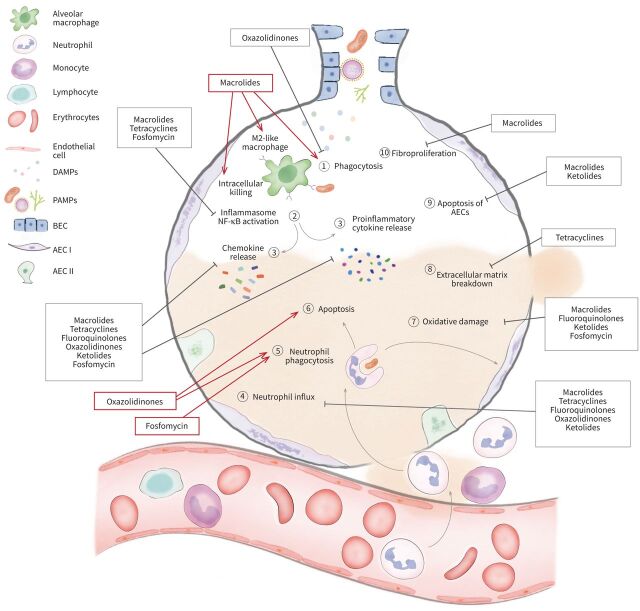FIGURE 2.
Immunomodulatory effects of antibiotics in acute respiratory distress syndrome (ARDS). (1) After pathogen invasion, macrolides enhance macrophage phagocytotic activity while oxazolidinones suppress phagocytosis. Macrolides promote the polarisation of proinflammatory M1 to anti-inflammatory M2 macrophages. (2) By sensing pathogen-associated molecular patterns (PAMPs) and damage-associated molecular patterns (DAMPs), Toll-like receptors (TLRs) become activated thereby triggering the activation of NF-κB which mediates the induction of proinflammatory cytokines and chemokines and the upregulation of the nucleotide-binding oligomerisation domain-like receptor family, pyrin domain containing protein-3 (NLRP3) inflammasome. Macrolides, tetracyclines and fosfomycin inhibit the activation of NF-κB and the NLRP3 inflammasome. (3) Macrolides, fluoroquinolones, ketolides, oxazolidinones, fosfomycin and tetracyclines inhibit the release of proinflammatory cytokines and chemokines causing impaired chemotaxis of immune cells (4) such as neutrophils and monocytes into the lungs. (5) Oxazolidinones and fosfomycin restore the phagocytotic capabilities of neutrophils. (6) Furthermore, they increase neutrophil apoptosis which is delayed in ARDS patients. (7) The oxidative damage caused by the generation of reactive oxygen species and nitric oxide (NO) metabolites by immune cells is decreased by macrolides, ketolides and fluoroquinolones. Fosfomycin also exhibits antioxidative properties. (8) Tetracyclines, as potent matrix metalloproteinase inhibitors, reduce extracellular matrix breakdown. (9) Macrolides and ketolides decrease apoptosis of alveolar epithelial cells while macrolides also prevent fibroproliferation. (10) The overall immunomodulatory effect of antibiotics in ARDS focuses on mitigating tissue injury by decreasing the intensity of an uncontrolled inflammatory response and enabling tissue repair. ⊥: Inhibition; →: stimulation; AEC I: type I alveolar epithelial cell; AEC II: type II alveolar epithelial cell; BEC: bronchial epithelial cell.

